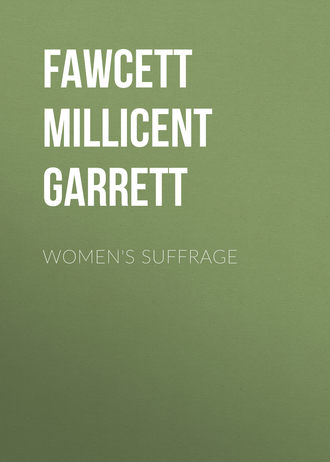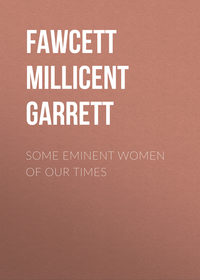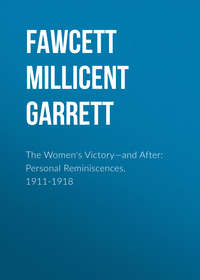 полная версия
полная версияWomen's Suffrage
Time was refused for the further stages necessary for its passage into law, and Parliament dissolved in November 1910.
In the new Parliament Sir George Kemp re-introduced the Bill; it was nearly the same Bill as that introduced by Mr. Shackleton; but it was given a more general title, leaving it open to amendment. The second reading of this Bill took place on May 5, 1911, and secured a majority of 167.
History of the Agitation in the CountryThe first women's suffrage societies were founded in Manchester, in London, and in Edinburgh in 1867, and in Bristol and in Birmingham in 1868.
These united to form the National Union of Women's Suffrage Societies.
This Union has grown into a large and powerful body, its progress during the last two years being especially remarkable.
In January 1909 there were 70 affiliated societies; in October 1911 there were 305 affiliated societies, and new societies are formed every week.
Societies of the National Union are now, therefore, in existence in all parts of Great Britain, and take an active part in electoral work. The National Union regards this part of its work as the most important it has to do, both as propaganda and as a means of bringing pressure to bear upon the Government. Its election policy is to oppose its enemies and support its friends, and in carrying out this policy it disregards all parties.
For the purposes of its peaceful propaganda, whether by public meetings, petitions, or other constitutional forms of agitation, the N.U.W.S.S. has, during the past year (1910), alone, raised considerably over £20,000. More than £100,000 has also been raised for suffrage work by the Women's Social and Political Union.
Public Meetings and DemonstrationsThese have been organised in great numbers. For example: —
In February 1907, 3000 women marched in procession in London, from Hyde Park to Exeter Hall.
In October 1907, 1500 women marched in procession through Edinburgh.
In October 1907, 2000 women marched in procession through Manchester.
In June 1908, 15,000 women marched in procession in London to the Albert Hall.
In June 1911 more than 40,000 women, representing all the suffrage societies, walked in a procession four miles long to the Albert Hall.
Public meetings have been held all over the country by all the suffrage societies. It is obviously impossible to enumerate them. We content ourselves with a rough estimate of meetings held in support of the "Conciliation Bill." These amount to, at least, 5000 meetings, including a demonstration in Hyde Park, attended by half a million people, a demonstration in Trafalgar Square, attended by 10,000 people. Also six Albert Hall meetings (two in one week), and demonstrations held in other cities than London, e. g., Manchester (2), Edinburgh, Bristol, Newcastle, Guildford, &c., &c.
These figures include meetings held by the N.U.W.S.S. and other societies; but leave out of account out-door meetings held in such numbers as to make even a rough estimate impossible. During the summer and autumn of 1910 there were at least two or three hundred every week.
Growth of the Movement outside the N.U.W.S.SMany other societies have been formed, having women's suffrage as their sole object. Such are the National Women's Social and Political Union, the Men's League for Women's Suffrage, the Women's Freedom League, the National Industrial and Professional Women's Suffrage Society, the New Union, the New Constitutional Society, the Men's Political Union, the Church League, the Free Church League, the League of Catholic Women, the League of the Society of Friends, the Tax-Resistance League. Besides such groups as the Artists' League, the Suffrage Atelier, the Actresses' Franchise League, the Society of Women Graduates, the Women Writers' Suffrage League, the Younger Suffragists, the Cambridge University Men's League, the London Graduates' Union for Women's Suffrage, the Gymnastic Teachers' Suffrage Society, &c., &c.
There is also the Irish Women's Suffrage and Local Government Association, and an Irish Women's Franchise League.
Within the political parties there have been formed the Forward Suffrage Union (within the Women's Liberal Federation), the Conservative and Unionist Women's Franchise Association, the People's Suffrage Federation (which demands the suffrage for all adult men and women).
The following organisations have officially identified themselves with the demand for some measure of women's suffrage: – the London Liberal Federation, the Women's Liberal Federation, the Welsh Women's Liberal Federation, the Independent Labour Party, the Fabian Society.
Other societies have repeatedly petitioned Parliament, or passed resolutions asking for a measure of women's suffrage. Among them the National British Women's Temperance Association (148,000 members), the Scottish Union of the above (42,000 members), the National Union of Women Workers (the largest Women's Union, numbers not exactly known), the International Council of Women, the Association of Headmistresses, the Association of University Women Teachers, the Incorporated Assistant Mistresses in Secondary Schools, the Society of Registered Nurses, the Nurses' International Congress, the Women's Co-operative Guild (the only organised body representing the married working-women of this country).
Resolutions in favour of the "Conciliation Bill" have been passed by 49 Trades and Labour Councils, and 36 Trades Unions and Federations. Moreover, during the year between October 1910 and October 1911 more than 130 Town and other local Councils petitioned Parliament in favour of women's suffrage; among the Town Councils who have done this are those of Liverpool, Manchester, Sheffield, Birmingham, Leeds, Bradford, Huddersfield, Brighton, Dover, Edinburgh, Glasgow, Dundee, Inverness, Dublin,[47] Limerick, Cork, Cardiff, and Bangor.
It is to be remembered that these bodies represent women as well as men, as women already possess the municipal franchise.
Women's Suffrage in other CountriesThe suffrage movement has now become world-wide. The International Women's Suffrage Alliance, which meets quadrennially, includes societies in Austria, Australia, Belgium, Bohemia, Bulgaria, Canada, Denmark, Finland, France, Germany, Great Britain, Hungary, Italy, Netherlands, Norway, Portugal, Russia, Cape Colony, Natal, Sweden, Switzerland, the United States.
Women's suffrage was granted in —

It will be noticed that all the Australian States have now granted women's suffrage. That they have done so proves that they realised its beneficial effects, where they could actually see it in working as State after State came into line.
1
Vindication of the Rights of Women, published in 1792.
2
See Le vote des Femmes, pp. 16-22, par Ferdinand Buisson, Député de la Seine et Président de la Commission du Suffrage Universelle. Condorcet had a predecessor in Mademoiselle Jars de Gournay, the friend of Montaigne. See Miss E. Sichel's Michel de Montaigne, p. 137.
3
Helen Blackburn's Record of Women's Suffrage, also Women in English Life, by Miss Georgina Hill. Mrs. Wheeler's daughter Rosina, married Mr. Lytton Bulwer, afterwards the first Lord Lytton. The present Earl of Lytton is thus the great-grandson of the lady who prompted the reply to James Mill's article referred to in the text.
4
This view has also been supported in France, see Le vote des Femmes, by Ferdinand Buisson, for evidence of women having in ancient times voted and sat in the Parlements of France. Taine also mentions the Countess of Perigord sitting in the États of her province prior to the Revolution (Les Origines de la France Contemporaire, par H. Taine, vol. i. p. 104).
5
Annals of a Yorkshire House, vol. ii. p. 319.
6
Report of the Manchester National Society for Women's Suffrage, 1869.
7
The Life of Mrs. Norton, by Miss Jane Gray Perkins (John Murray).
8
The date of this speech is given in Miss Blackburn's Record of Woman's Suffrage as 1866, the only mistake I have found in her careful and faithful history.
9
See the interesting picture in the staircase of the National Portrait Gallery, London.
10
Morley's Life of Gladstone, vol. i. p. 571.
11
James Mill: a Biography, by Alexander Bain, LL.D., p. 215.
12
Representative Government, by J. S. Mill, pp. 175-180.
13
Dissertations and Discussions, by J. S. Mill, vol. ii. p. 417.
14
Autobiography, p. 241.
15
The census of 1911 shows that the excess of women over men is in the proportion of 1068 women to 1000 men, and that this proportion has changed but little during the last hundred and ten years.
16
Record of Women's Suffrage, by Helen Blackburn, pp. 53, 54, 55.
17
Record of Women's Suffrage, p. 190, by Helen Blackburn.
18
A few isolated associations of Liberal women had existed before this. There was one at Bristol started in 1881; but nothing was done on an extended scale till 1886.
19
An important new departure in journalism was taken by The Standard in October 1911. This paper now devotes more than a page daily to a full statement both of events and arguments bearing on all sides of the suffrage and other women's questions.
20
See Outlines of the Women's Franchise Movement in New Zealand, by W. Sydney Smith. Whitecombe & Tombs, Ltd., Christchurch, N.Z. 1905.
21
See Report by Sir Charles Lucas, who visited New Zealand on behalf of the Colonial Office in 1907.
22
See Colonial Statesmen and Votes for Women, published by The Freedom League, p. 6.
23
See letter from Miss Alice Stone Blackwell in Manchester Guardian, July 12, 1911.
24
See Anti-Suffrage Review, No. 33, p. 167.
25
The exact numbers in England and Wales (autumn 1911) are fifteen on Town Councils (two being Mayors) and four on County Councils.
26
As an example I quote the canvass of women municipal electors in Reading made respectively by the suffragists in 1909 and anti-suffragists in 1911. When the suffragists canvassed, the results were: —

When the anti-suffragists canvassed in 1910 the results were: —

With such disparity as this between the two returns no conclusion can possibly be drawn from either without further investigation of the methods pursued.
27
See Statistical Abstract from the United Kingdom.
28
Quoted in Lord Morley's Studies in Literature, pp. 133, 134. The reference there given for the extract is Order and Progress, by Frederic Harrison, pp. 149-154.
29
Early History of Charles James Fox, by the Rt. Hon. Sir G. O. Trevelyan, p. 449.
30
Anti-Suffrage Review, December 1910.
31
See p. 89.
32
See The Suffragette, by Miss E. Sylvia Pankhurst (Gay and Hancock, 1911).
33
See Garibaldi and the Making of Italy, by G. M. Trevelyan, p. 3.
34
Morley's Life of Gladstone, vol. iii. p. 371.
35
I have in my possession positive proof that orders were given to the police not to arrest a particular lady whose name is well known and highly respected in every part of the country.
36
I am requested by the Women's Freedom League to state that they have never resorted to stone-throwing or to personal assaults.
37
A third protest was published in December 1911.
38
Morley's Life of Oliver Cromwell, pp. 232-3.
39
See Summing up of Mr. Justice Avory in Hawkins v. Muff case. A Warning to Liberal Stewards, published by the Men's Political Union, 1911.
40
More Tramps Abroad, by Mark Twain, p. 208.
41
See the Annual Report of the National Union of Women's Suffrage Societies presented in March 1910.
42
Standard, Oct. 17, 1911.
43
See resolution adopted by the executive committee of the Women's Liberal Federation, quoted in Standard, October 30, 1911: —
"That … the executive resolves that until definite promises are made of a Government Reform Bill including women they will support by all means in their power the Bill promoted by the Conciliation Committee and will pursue with regard to amendments to that Bill such a policy as circumstances show to be most likely to secure for it a substantial third reading majority."
44
See "Political Notes," Times, November 24, 1910.
45
The Woman's Social and Political Union dissented from this view. They resumed militant tactics, and scenes of considerable disorder occurred on November 21 and November 29, 1911.
46
These speeches can be obtained from the Women's Liberal Federation, 2 Victoria Street, London, S.W.
47
The Corporation of Dublin authorised the Lord Mayor and other officers to attend in their robes and present the Dublin petition in person at the Bar of the House of Commons.



